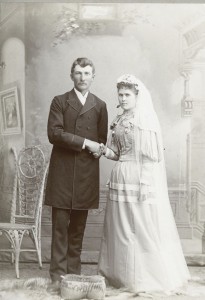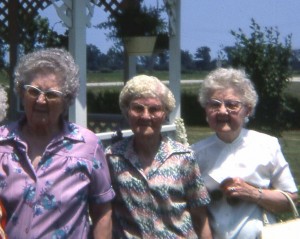March is Women’s History month. Women were the heart of the family and have made many contributions to society over the years. We all have fond memories of our mothers and grandmothers and for the generations of women beyond them, we rely on family stories and search for additional information about them.
Women were actually included in quite a few records, such as vital records (birth/marriage/death), tombstone inscriptions, church records, census records, passenger lists, directories, military records and pensions, land records, guardianships, wills and probate, court records, newspaper items, and published histories.

Unknown ladies from Schinnerer/Scaer album; Longsworth & Agler photo, Van Wert
That is a good list of sources, but female ancestors can still be a research challenge, as we try to learn who their parents were, their maiden name, and what happened to them.
For one thing, a woman’s name usually changed when she married. A few weeks ago I wrote that years ago it was the society norm to call a married women by her husband’s given name, e.g. Mrs. John Doe. When you think about it, the woman completely changed her name when she married. She basically took her husband’s given name and surname. Jane Smith became Mrs. John Doe. Thank goodness census reports show the woman’s actual given name, although it might be in the form of nickname or shortened version of the name.
The above is a fairly long list of possible sources of information, but I usually use a few specific ones for research from here at home. Below are some examples of where I research women, the ones I use most.
Censuses
Census enumerations are one of my favorite sources of information for anyone, but especially women. Family members were not specified (wife/daughter/son) until the 1880 census but sometimes in the 1850-70 censuses I will see “helps mother.” That indicates a relationship to me. From 1880 on, wives and daughters are identified.
Some of my favorite census years and their questions for information about women:
1900: How long the couple has been married; number of children the woman gave birth to; how many of those children were living; when the individual immigrated; birth month & year of each person.
1910: Number of children the woman gave birth to; how many of those children were living; the number of the couple’s marriage (1st, 2nd ); number of years married.
1930: The person’s age at first marriage.
Years ago, before assisted living homes were common, older, widowed women often lived with their children or one of their siblings, so it is important to research all members of a family, not just your direct line.
Marriage Records
Marriage records include civil records and church records, although church records may not exist or be available.
We want to know who a woman married and when.
The problem: I know a woman was married to a certain man, but I can’t find their marriage by using her maiden name.
The solution: This may be her second or third marriage, but I assumed it was her first marriage. On a marriage record, her surname will usually be the surname of the man to whom she was just previously married. If she was married several times and you don’t know about one of those marriages, you may have a problem finding a later marriage for her.
Another hint: Add the names of the women’s parents into her marriage search. The parent’s names were often included on a marriage license.
Other information is often included on a marriage license and marriage record: the ages and birth dates of the bride and groom, their place of birth, current residence, occupation, number of marriage.
A woman may have been included in various records generated during the time she was married to each husband, so researching all the husbands may turn up additional information.
Having an unusual name is also helpful. But it is a mixed blessing. An unusual name may be easier to find but it is also easier to misspell and index. Add poor penmanship to that and some names are difficult to find no matter what.
Some interesting given names I have recently run across in my research include Blossom, Ivadeen, Echo, Gladysmae, and Carmaletta.
It appears some women are drawn to men with unusually long surnames. I recently ran across a woman who married Mr. Stoppenhagen and after his death she married Mr. Sassmannshausen. Another woman, whose maiden name was Haendschke, married Mr. Jesowshek. Challenging surnames indeed.

John & Elizabeth (Schinnerer) Scaer, 1894.
Obituaries
Obituaries can be very helpful in researching women, giving a lot of family information (parents, children, grandchildren) and some occupational and personal information as well. Search for an obituary by using both a woman’s maiden name and her married name. Previously unknown surnames may show up in an obituary, often used in conjunction with the children’s names, and may be clues to a previous marriage.
In an obituary, a woman’s name may be shown as husband’s name, e.g. Mrs. John Doe. In that instance, you would not find the obituary searching for Jane Doe.
Other obituary search tips: Search by using the full name of one or more of her surviving children. Search for her siblings. Search for her last name and the married surname of one of her daughters or sisters.

Scaer sisters: Elsie Roehm, Hilda Schumm, Edna Schumm.
Speaking of newspaper obituaries, on-line newspaper subscriptions are a good source for finding obituaries as well as for reading regular, society articles. Look for engagement and wedding announcements, where parents are mentioned, as well as siblings or cousins, who may have been wedding attendants. Newspapers often include photos. It is interesting to see photos of the people you are researching. It brings them to life and you see that they are not just names, dates and places.
Perhaps a woman belonged to a local society or card club. She may be mentioned in the news for any number of things.
I use FindaGrave.com regularly and a woman is usually entered there with her last married name. FindaGrave.com also usually includes a woman’s maiden name and links to memorials of deceased family members. Their information is pretty accurate, but I have found a few errors. Often times an obituary is included in the FindaGrave.com memorial, which is a real plus.
Occasionally, a woman’s tombstone inscription will include her maiden name.
Finally, the birth and/or death record of any of a woman’s children may reveal previously unfound information about the mother.
Basically, search a wide variety of sources for information and hopefully you will be rewarded with some new information and insights into your female ancestors, and other ancestors as well.
You may soon be doing the Genealogy Happy Dance.



2 comments
For your lady’s nicknames column, My mother passed in 2020. Her name was Nelletta Sidle Reidenbach and she had two nicknames. Nell and Nellie. She was born and raised in Van Wert, she was 95.
Author
Interesting nicknames, but I think her given name was even more unusual.